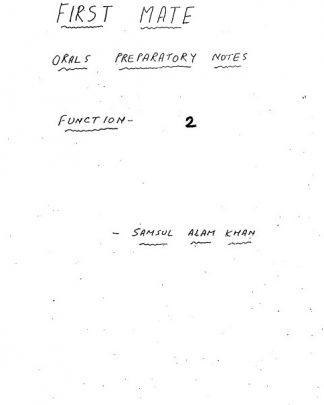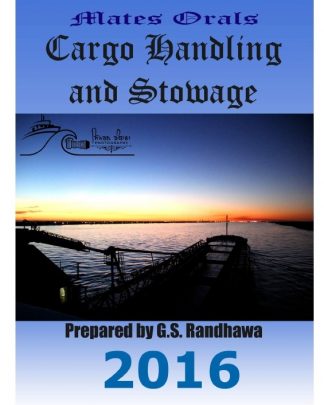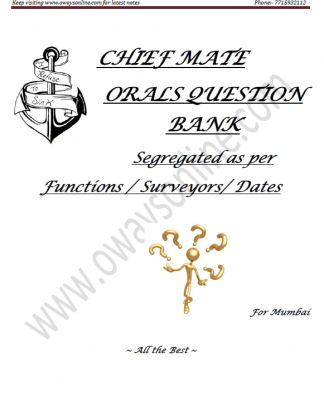On Questions regarding ROR, ensure that you answer word to word from Cockroft- ROR book.
How many rules in ROR?
There are a total of 38 rules in the International Regulations for Preventing Collisions at Sea (COLREGS), which are commonly known as the “Rules of the Road.” These rules were established by the International Maritime Organization (IMO) and are intended to promote safe navigation and prevent collisions between vessels at sea.
Part B Section 3 of ROR:
Part B Section 3 of the International Regulations for Preventing Collisions at Sea (COLREGS) pertains to conduct of vessels in restricted visibility.
Restricted visibility is defined as any condition in which visibility is restricted by fog, mist, falling snow, heavy rainstorms, sandstorms, or any other similar causes. In such conditions, the OOW must take appropriate measures to navigate the vessel safely and avoid collisions.
Key Rules under Part B Section 3 of COLREGS:
- Rule 19: Every vessel should proceed at a safe speed that is appropriate for the conditions, while taking into account any restrictions to visibility.
- Rule 20: Every vessel should use its navigation lights to signal its presence and its status to other vessels in the vicinity.
- Rule 21: Every vessel should sound the appropriate signal for restricted visibility to indicate its position, course, and speed to other vessels in the vicinity.
- Rule 22: Every vessel should listen to the appropriate signal for restricted visibility and take the necessary action to avoid collision.
- Rule 23: Every vessel should use radar to determine the presence, course, and speed of other vessels in the vicinity, and to take appropriate action to avoid collision.
- Rule 35: Every vessel should avoid anchoring in or near a narrow channel or where it may obstruct or foul a channel.
- Rule 36: Every vessel should avoid impeding the passage of other vessels in a narrow channel by taking action well in advance, using all available means, to keep clear of other vessels and avoid causing a danger of collision.
In summary, Part B Section 3 of COLREGS provides guidance for the safe navigation of vessels in conditions of restricted visibility, including the use of navigation lights, sounding of appropriate signals, use of radar, and taking action to avoid collisions.
Rule 29: Pilot Vessels
- (a) A vessel engaged in pilotage duty shall exhibit:
- (i) at or near the masthead, two all-round lights in a vertical line, the upper being white and the lower red;
- (ii) when underway, in addition, sidelights and a sternlight.
- (iii) when at anchor, in addition to the lights prescribed in subparagraph (i), the light, lights or shape prescribed in Rule 30 for vessels at anchor.
- (b) A pilot vessel when not engaged on pilotage duty shall exhibit the lights or shapes prescribed for a similar vessel of her length.
Rule 6 b of ROR:
Every vessel shall at all times proceed at a safe speed so that she can take proper and effective action to avoid collision and be stopped within a distance appropriate to the prevailing circumstances and conditions.
In determining a safe speed, the following factors shall be among those taken into account:
b) Additionally, by vessels with operational radar:
- (i) the characteristics, efficiency and limitations of the radar equipment;
- (ii) any constraints imposed by the radar range scale in use;
- (iii) the effect on radar detection of the sea state, weather and other sources of interference;
- (iv) the possibility that small vessels, ice and other floating objects, may not be detected by radar at an adequate range;
- (v) the number, location and movement of vessels detected by radar;
- (vi) the more exact assessment of the visibility that may be possible when radar is used to determine the range of vessels or other objects in the vicinity.
Rule 19 b of ROR:
Every vessel shall proceed at a safe speed adapted to the prevailing circumstances and conditions of restricted visibility. A power-driven vessel shall have her engines ready for immediate manaeuvre.
Rule 32: Definitions
- (a) The word ‘whistle’ means any sound signalling appliance capable of producing the prescribed blasts and which complies with the specifications in Annex I11 to these Regulations.
- (b) The term ‘short blast’ means a blast of about one second’s duration.
- (c) The term ‘prolonged blast’ means a blast of from four to six seconds’ duration.
Rule 34(d):
When vessels in sight of one another are approaching each other and from any cause either vessel fails to understand the intentions or actions of the other, or is in doubt whether sufficient action is being taken by the other to avoid collision, the vessel in doubt shall immediately indicate such doubt by giving at least five short and rapid blasts on the whistle. Such signal may be supplemented by a light signal of at least five short and rapid flashes.
Rule 38: Exemptions
Any vessel (or class of vessels) provided that she complies with the requirements of the International Regulations for Preventing Collisions at Sea, 1960, the keel of which is laid or which is at a corresponding stage of construction before the entry into force of these Regulations, may be exempted from compliance therewith as follows:
- (a) The installation of lights with ranges prescribed in Rule 22, until four years after the date of entry into force of these Regulations.
- (b) The installation of lights with colour specifications as prescribed in Section 7 of Annex I to these Regulations, until four years after the date of entry into force of these Regulations.
- (c) The repositioning of lights as a result of conversion from Imperial to metric units and rounding off measurement figures, permanent exemption.
- (d) (i) The repositioning of masthead lights on vessels of less than 150 metres in length, resulting from the prescriptions of Section 3(a) of Annex I to these Regulations, permanent exemption.
- (ii) The repositioning of masthead lights on vessels of 150 metres or more in length, resulting from the prescriptions of Section 3(a) of Annex I to these Regulations, until
- nine years after the date of entry into force of these Regulations.
- (e) The repositioning of masthead lights resulting from the prescriptions of Section 2(b) of Annex I to these Regulations, until nine years after the date of entry into force of these Regulations.
- (f) The repositioning of sidelights resulting from the prescriptions of Sections 2(g) and 3(b) of Annex I to these Regulations, until nine years after the date of entry into force of these Regulations.
- (g) The requirements for sound signal appliances prescribed in Annex I11 to these Regulations, until nine years after the date of entry into force of these Regulations.
- (h) The repositioning of all-round lights resulting from the prescription of Section 9(b) of Annex I to these Regulations, permanent exemption.
Which all rules apply in restricted visibility?
When a vessel is operating in restricted visibility, which is defined as any condition where visibility is restricted by fog, mist, falling snow, heavy rainstorms, sandstorms, or any other similar causes, the International Regulations for Preventing Collisions at Sea (COLREGs) require that certain specific rules be followed to prevent collisions. Here are some of the key rules that apply in restricted visibility:
- Rule 19: Conduct of vessels in restricted visibility: This rule requires that vessels in restricted visibility proceed at a safe speed, use their radar and other navigational aids to the fullest extent possible, and avoid any maneuvers that would create a risk of collision. If necessary, vessels must take early and substantial action to avoid a collision, and if a risk of collision is detected, they must use all available means to determine the other vessel’s course and speed.
- Rule 35: Sound signals in restricted visibility: This rule requires vessels in restricted visibility to make appropriate sound signals to indicate their position, course, and speed. Vessels should use the appropriate signals based on their size and type, and should also listen for signals from other vessels to help determine their position and course.
- Rule 7: Risk of collision: This rule requires vessels to use all available means to determine if there is a risk of collision, and to take action to avoid such risk. In restricted visibility, this may involve using radar, sound signals, and other navigational aids to detect the presence and course of other vessels.
- Rule 8: Action to avoid collision: This rule requires vessels to take early and substantial action to avoid a collision, and to make the action apparent to the other vessel as soon as possible. In restricted visibility, this may involve using sound signals, altering course, reducing speed, or taking other appropriate actions to avoid a collision.
- Rule 19(d): Departure from these rules: This rule allows vessels to depart from the rules in order to avoid immediate danger, but only to the extent necessary to avoid such danger. If a vessel departs from the rules, it must sound the appropriate signal to indicate its actions to other vessels.
Short Blast:
In the context of marine navigation, a short blast refers to a sound signal made using a vessel’s whistle or horn. The sound of a short blast is a sharp and brief emission of sound, typically lasting about one second.
The purpose of a short blast is to communicate a specific message or warning to other vessels in the vicinity. Short blasts are used in a variety of situations, including:
- When a vessel is changing its course to port (left), it should sound one short blast to indicate its intention.
- When a vessel is changing its course to starboard (right), it should sound two short blasts to indicate its intention.
- A vessel may sound one short blast when approaching a bend or intersection in a narrow channel or fairway.
- When underway but stopped and making way through the water, a vessel may sound one short blast every two minutes to indicate its position and direction of movement.
- In restricted visibility, a vessel should sound one short blast every two minutes to indicate its position and direction of movement.
- A vessel may sound a series of short blasts to signal danger, such as an obstacle or other hazard.
Prolonged Blast:
A prolonged blast is a continuous sounding of a horn or whistle on a vessel. The purpose of a prolonged blast is to signal the vessel’s presence and its intention to maneuver in a certain way or to warn other vessels of danger.
Here are some points on when and how to use a prolonged blast:
- A prolonged blast of at least 4-6 seconds is used as a warning signal to indicate that a vessel is about to get underway and is making way through the water.
- A prolonged blast of at least 4-6 seconds is used as a signal for a vessel to signify that it is changing its course to port.
- A prolonged blast of at least 4-6 seconds is used as a signal for a vessel to signify that it is changing its course to starboard.
- A prolonged blast of at least 4-6 seconds is used as a signal for a vessel to signify that it is stopping or reducing its speed.
- A prolonged blast of at least 4-6 seconds is used as a warning signal to indicate that a vessel is approaching a bend or area of reduced visibility on a narrow channel or fairway.
- In foggy conditions, a prolonged blast of at least 6-8 seconds is used by a vessel at anchor to signal its presence.
- A prolonged blast of at least 4-6 seconds is used in case of danger or emergency situations, such as to warn other vessels of the vessel’s position, to request assistance or to warn other vessels to keep clear.


